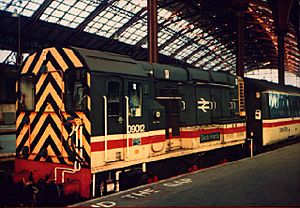British Rail Class 09 facts for kids
Quick facts for kids British Rail Class 09 |
|
 |
|
| 09012 at Brighton station | |
| Power type | Diesel-electric |
|---|---|
| Builder | British Railways Darlington Works, Horwich Works |
| Configuration | 0-6-0 |
| Gauge | 4 ft 8 1⁄2 in (1,435 mm) |
| Wheel diameter | 4 ft 6 in (1.372 m) |
| Minimum curve | 3.5 chains (70 m) |
| Wheelbase | 11 ft 6 in (3.51 m) |
| Length | 29 ft 3 in (8.92 m) |
| Width | 8 ft 6 in (2.59 m) |
| Height | 12 ft 8+1⁄2 in (3.87 m) |
| Locomotive weight | 49 long tons (49.8 t) |
| Fuel capacity | 668 imp gal (3,040 L; 802 US gal) |
| Prime mover | English Electric 6KT |
| Traction motors | English Electric 506, 2 off |
| Transmission | DC generator, DC traction motors, double reduction gearing |
| Top speed | 27.5 mph (44.3 km/h) |
| Power output | Engine: 350 hp (261 kW) |
| Tractive effort | Maximum: 35,000 lbf (155.7 kN) Continuous: 8,800 lbf (39.1 kN) |
| Train heating | None |
| Locomotive brakeforce | 19 long tons-force (189 kN) |
| Train brakes | originally vacuum, later dual, some now air only |
| Career | British Rail |
| Number | D3665–D3671, D3719–D3721, D4099–D4114; later 09001–09026 |
| Axle load class | RA 5 |
The British Rail Class 09 is a type of diesel locomotive that was built mainly for shunting. Shunting means moving railway wagons or carriages around in a railway yard or station. These locomotives could also pull freight trains for short distances on smaller railway lines.
The Class 09 locomotives are very similar to another type of shunting engine called the Class 08. However, the Class 09s were designed to go a bit faster. They could reach a top speed of 27.5 mph (44 km/h). To do this, they had to give up some of their pulling power, known as tractive effort. When they were first built, these locomotives mostly worked in the southern parts of the British railway network. After the railway system was privatized in 1997, these engines started to be used in many different places across the country.
Contents
What is a Class 09 Locomotive?
The Class 09 is a special type of train engine that runs on diesel fuel and uses electricity to power its wheels. This is why it's called a diesel-electric locomotive. It has a wheel arrangement known as 0-6-0. This means it has six driving wheels in the middle and no wheels at the front or back that aren't powered.
How Were They Built?
These powerful engines were built by British Railways at two of their workshops: Darlington Works and Horwich Works. The first ones were made in 1959, and more were built in 1961. They were designed to be strong and reliable for their important shunting jobs.
What Jobs Did They Do?
The main job of a Class 09 locomotive was to move railway wagons around in busy train yards. Imagine a giant puzzle where you need to put train cars in the right order to make a new train. That's what shunting is! They also helped move goods for short distances, especially on smaller railway lines that connected to bigger ones. Their design allowed them to handle tight turns in railway yards.
Key Features of the Class 09
The Class 09 locomotives have several interesting features that make them good at their jobs.
Engine and Power
Each Class 09 locomotive has an English Electric 6KT engine. This engine produces about 350 horsepower. This power is used to generate electricity, which then drives the wheels. This system allows the locomotive to move heavy loads slowly and carefully, which is perfect for shunting.
Speed and Pulling Power
While they were designed for shunting, the Class 09s could reach a top speed of 27.5 mph (44 km/h). This was faster than the Class 08 shunting engines. However, to achieve this speed, they had a slightly lower maximum pulling power compared to the Class 08s. Their maximum pulling force was around 35,000 lbf (156 kN).
Brakes and Weight
Originally, these locomotives used a type of brake system called "vacuum brakes." Later, some were updated to use "dual brakes" (both vacuum and air), and some now only use "air brakes." The locomotive itself weighs about 49 long tons.
Where Are They Now?
After the British railway system was privatized in 1997, many Class 09 locomotives were sold to different railway companies. This meant they started working in new places, far from their original home in the Southern Region of British Railways. Some are still used today for shunting and light freight duties, showing how well they were built.
Images for kids


